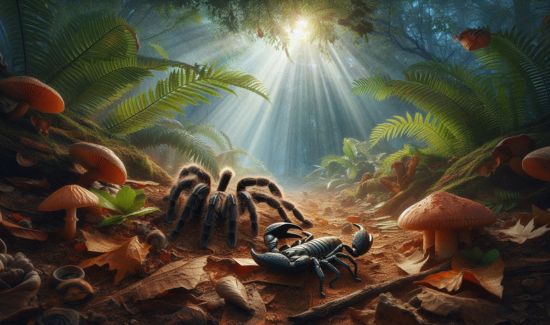Introduction
Table of Contents
Tarantula and scorpion are two of the most intriguing arachnids found on our planet. Though they might look scary, these creatures play a vital role in our ecosystem. From their unique adaptations to their surprising behaviors, there’s much to discover about these often misunderstood animals. This article will take you on a journey into the world of tarantulas and scorpions, providing interesting facts and insights that are easy for everyone, to understand. So, let’s dive into the fascinating world of these arachnids, exploring their differences, habitats, and much more!
Understanding Tarantula and Scorpion
1. What Are Tarantulas?
Tarantulas are large, hairy spiders belonging to the Theraphosidae family. They can be found in various habitats, including rainforests, deserts, and grasslands, mostly in warm climates.
- Physical Features: Tarantulas are known for their hairy bodies and legs, which help them sense vibrations in their environment. They have eight eyes but rely more on touch and vibration than sight to navigate their surroundings.
- Behavior: Although they might seem intimidating, tarantulas are generally shy creatures. They are nocturnal hunters, meaning they come out at night to search for prey like insects, small birds, and other small animals.
- Defensive Mechanisms: When threatened, tarantulas can flick urticating hairs from their abdomen, which can irritate the skin or eyes of predators.
- Habitat: Tarantulas are native to the Americas, Asia, and Africa. They prefer warm climates and can be found in rainforests, deserts, and even urban areas.
2. What Are Scorpions?
Scorpions are arachnids known for their segmented tails that end with a venomous stinger. They belong to the Scorpion’s order and have been around for hundreds of millions of years.
- Physical Features: Scorpions have a pair of pincers (pedipalps) used to grasp prey and a long tail with a venomous stinger at the end. Their exoskeletons glow under ultraviolet light, a unique characteristic among arachnids.
- Behavior: Scorpions are also nocturnal hunters. They feed on insects, spiders, and even small vertebrates. Their venom is used to subdue prey and defend against threats.
- Defensive Mechanisms: In addition to their venomous sting, scorpions use their pincers to defend themselves. Some species also burrow to hide from predators.
- Habitat: Scorpions are found on every continent except Antarctica. They thrive in desert environments but can also be found in forests, grasslands, and caves.
Key Differences Between Tarantula and Scorpion
1. Physical Appearance
One of the most noticeable differences between tarantula and scorpion is their appearance. While tarantulas have hairy bodies with eight legs, scorpions have segmented bodies with pincers and a tail ending in a stinger.
2. Diet
Both tarantulas and scorpions are carnivorous, but their diets vary. Tarantulas primarily eat insects, while scorpions can feed on a broader range of prey, including other scorpions.
3. Hunting Techniques
Tarantulas use stealth and their powerful jaws to catch prey, often ambushing them. Scorpions, on the other hand, rely on their pincers and stinger to capture and immobilize their prey.
4. Lifespan
Tarantulas generally have longer lifespans than scorpions. While tarantulas can live up to 30 years in captivity, most scorpions live between 3 to 8 years.
5. Venom
Both creatures possess venom, but its potency and effects differ. Tarantula venom is typically mild for humans, causing only localized pain and swelling. Scorpion venom can range from mild to highly toxic, with some species being potentially fatal to humans.

Habitats of Tarantula and Scorpion
1. Tarantulas in the Wild
Tarantulas are found in a variety of habitats around the world, from the rainforests of South America to the deserts of the southwestern United States. They live in burrows or crevices, where they can hide from predators and ambush their prey.
2. Scorpions in the Wild
Scorpions are incredibly adaptable and can survive in some of the harshest environments on Earth. They are commonly found in deserts, but some species live in forests, caves, and grasslands. Like tarantulas, scorpions also prefer to hide during the day and emerge at night to hunt.
The Role of Tarantula and Scorpion in the Ecosystem
1. Natural Pest Control
Both tarantulas and scorpions play a crucial role in controlling insect populations. By preying on pests, they help maintain balance in their ecosystems.
2. Prey for Larger Animals
While they are predators themselves, tarantulas and scorpions are also prey for larger animals, such as birds, reptiles, and mammals. This makes them an essential part of the food chain.
How to Safely Observe Tarantula and Scorpion
1. Observing Tarantulas
If you come across a tarantula in the wild, it’s important to remain calm and keep your distance. Tarantulas are generally not aggressive and will only bite if provoked.
2. Observing Scorpions
Scorpions are more likely to sting if they feel threatened. If you see one, avoid handling it and observe from a safe distance. Remember, not all scorpions are dangerous, but it’s best to be cautious.
Common Myths About Tarantula and Scorpion
1. Myth: Tarantulas Are Deadly to Humans
While tarantulas can bite, their venom is usually not harmful to humans. Most bites result in mild symptoms similar to a bee sting.
2. Myth: All Scorpions Are Dangerous
Not all scorpions are deadly. In fact, most scorpion stings cause only mild discomfort. However, it’s still important to treat all scorpions with respect and caution.
Interesting Facts About Tarantulas and Scorpions
- Tarantulas: Some tarantula species can regenerate lost legs during molting.
- Scorpions: Scorpions give birth to live young, which ride on their mother’s back until they are ready to fend for themselves.
Conclusion
Tarantulas and scorpions are fascinating creatures that deserve our respect and understanding. While they may seem intimidating, they play vital roles in their ecosystems by controlling insect populations and serving as prey for larger animals. By learning more about these incredible arachnids, we can appreciate the important part they play in nature. Whether you’re exploring the deserts of the southwestern United States or the rainforests of South America, keep an eye out for these amazing creatures, and remember to observe them safely from a distance.
Table of Information: Tarantula and Scorpion
| Feature | Tarantula | Scorpion |
|---|---|---|
| Physical Features | Hairy body, 8 legs, 8 eyes | Segmented body, pincers, stinger |
| Diet | Insects, small animals | Insects, spiders, small vertebrates |
| Lifespan | Up to 30 years | 3 to 8 years |
| Venom | Mild, localized pain | Ranges from mild to highly toxic |
| Habitat | Rainforests, deserts, urban areas | Deserts, forests, grasslands |
FAQs
- Are tarantulas dangerous to humans?
- No, tarantulas are not dangerous to humans. Their bites are typically mild and cause only minor discomfort.
- Can scorpions kill humans?
- Some scorpion species have venom that can be fatal, but most scorpion stings are not life-threatening.
- Where do tarantulas live?
- Tarantulas live in a variety of habitats, including rainforests, deserts, and grasslands.
- What do scorpions eat?
- Scorpions eat insects, spiders, and small vertebrates.
- How long can tarantulas live?
- Tarantulas can live up to 30 years, especially in captivity.

